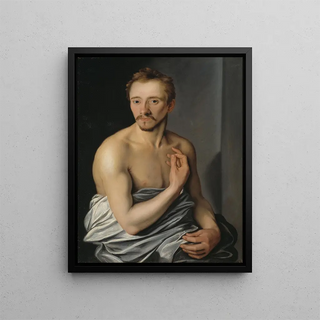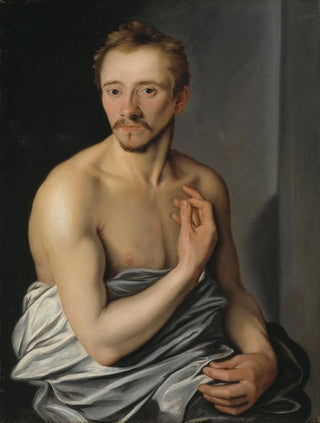Painting Study of a Model called Lasse Lucidor - Cornelis Cornelisz Kunst


View from behind

Frame (optional)
"Étude de modèle appelée Lasse Lucidor" by Cornelis Cornelisz Kunst captivates with its elegance and intimate atmosphere. In this piece, the Dutch artist of the 16th century manages to capture not only the physical form of the model but also an emotional essence that transcends centuries. This representation, both simple and profound, invites us to contemplate the beauty of the human figure while immersing us in a rich and nuanced artistic universe. The art print of this work allows us to rediscover a moment in art history when the depiction of the human body was refined, revealing subtle details that testify to the undeniable talent of the artist.
Style and uniqueness of the work
The originality of the "art print called Lasse Lucidor" lies in how Kunst uses light and shadow to shape volumes and bring his subject to life. The contours of the model are drawn with remarkable delicacy, while the shades of color evoke an atmosphere of serenity and contemplation. The artist manages to balance the rigor of drawing with palpable expressiveness, making the model both accessible and mysterious. This subtle play between realism and idealization is characteristic of the period, where artists sought to transcend mere representation to achieve a deeper form of expression. Thus, each view of this art print becomes an invitation to explore the feelings and reflections it evokes.
The artist and his influence
Cornelis Cornelisz Kunst, an emblematic figure of Dutch painting, established himself through his unique approach to portraiture and art prints of models. His career, marked by a constant pursuit of technical perfection and emotional expression, influenced many contemporary and future artists. Kunst does not merely reproduce reality; he interprets, transforms, and elevates it to a higher artistic level. His work reflects an era where humanism and the rediscovery of classics fueled the creativity of painters. By focusing on capturing the soul of his models, Kunst paved the way for a new way of conceiving portraiture, where the individual

Matte finish

View from behind

Frame (optional)
"Étude de modèle appelée Lasse Lucidor" by Cornelis Cornelisz Kunst captivates with its elegance and intimate atmosphere. In this piece, the Dutch artist of the 16th century manages to capture not only the physical form of the model but also an emotional essence that transcends centuries. This representation, both simple and profound, invites us to contemplate the beauty of the human figure while immersing us in a rich and nuanced artistic universe. The art print of this work allows us to rediscover a moment in art history when the depiction of the human body was refined, revealing subtle details that testify to the undeniable talent of the artist.
Style and uniqueness of the work
The originality of the "art print called Lasse Lucidor" lies in how Kunst uses light and shadow to shape volumes and bring his subject to life. The contours of the model are drawn with remarkable delicacy, while the shades of color evoke an atmosphere of serenity and contemplation. The artist manages to balance the rigor of drawing with palpable expressiveness, making the model both accessible and mysterious. This subtle play between realism and idealization is characteristic of the period, where artists sought to transcend mere representation to achieve a deeper form of expression. Thus, each view of this art print becomes an invitation to explore the feelings and reflections it evokes.
The artist and his influence
Cornelis Cornelisz Kunst, an emblematic figure of Dutch painting, established himself through his unique approach to portraiture and art prints of models. His career, marked by a constant pursuit of technical perfection and emotional expression, influenced many contemporary and future artists. Kunst does not merely reproduce reality; he interprets, transforms, and elevates it to a higher artistic level. His work reflects an era where humanism and the rediscovery of classics fueled the creativity of painters. By focusing on capturing the soul of his models, Kunst paved the way for a new way of conceiving portraiture, where the individual






